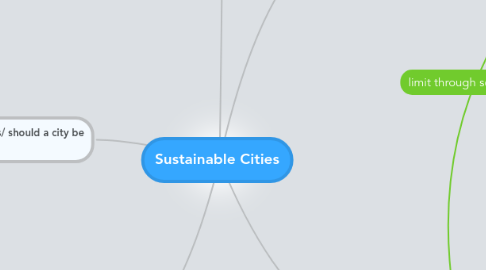
1. impact of nature in cities
1.1. psychology
1.1.1. nature awareness: effects on human behavior?
1.1.1.1. question
1.1.1.1.1. How could the connection between man and nature in the urban environemnt be re-established and made visible? What effects does nature-awareness have on people and their behaviour?
1.1.2. vital to human well-being?
1.1.2.1. encounter in daily life
1.1.2.1.1. question
1.1.2.2. biophilic cities
1.1.2.2.1. sustainable?
1.1.2.2.2. question
1.2. technology
1.2.1. UHI mitigation+ biodiversity corridors
1.2.1.1. potential synergies/ issues
1.2.1.1.1. question
1.2.2. evaluate best practices in terms of urban design to specific loval context
1.2.2.1. question
1.2.2.1.1. How can we evaluate examples of best practices in terms of urban design? How do you select, adapt, and implement solutions options that exist around the world (e.g., those mentioned in the Sustainable Cities video Masdar, IBM Smart Cities, Urban Omnibus) to a different local context (in this case, Phoenix or Lüneburg)?
2. development of cities
2.1. impact of History
2.1.1. understand urban+ social structures
2.1.1.1. history of managing, conserving, restoring wildlife
2.1.1.1.1. question
2.1.1.2. American cities: influence of individualism
2.1.1.2.1. How did individualism as a value contribute to shape American cities? How did American cities develop?
2.1.1.3. question
2.1.1.3.1. What we can learn from the history of our cities to understand their current urban and social structures?
2.1.2. learn from history
2.1.2.1. native American settlements: reasons for collapse
2.1.2.1.1. question
2.2. adaption and mitigation
2.2.1. question
2.2.1.1. How do policy options for urban climate adaptation/mitigation look like? In how far are they possible to generalize?
2.2.2. question
2.2.2.1. What are the “unconscious efficiencies” within cities that allow urban dwellers to be more sustainable than rural residents? Should the search for sustainability be more about encouraging a more “conscious” set of behaviors and a more explicit ethic of sustainable living? Why/why not?
3. for whom is/ should a city be good?
4. decision makers of city
4.1. question
4.1.1. Who is involved in the decision making process (e.g., experts? communities?)? What roles do these decision-makers play?
4.2. role of order?
4.2.1. economy
4.2.1.1. how internalize social, ecological, cultural phenomenon
4.2.1.1.1. question
4.2.1.2. globalized competition
4.2.1.2.1. question
4.2.1.3. sustainable development
4.2.1.3.1. economic infrastrucutre (supply chains)
4.2.1.3.2. consumer behavior
4.2.2. governance
4.2.2.1. organize change/strategies for change
4.2.2.1.1. top-down
4.2.2.1.2. bottom-up
4.2.2.1.3. questions
4.2.2.2. structure
4.2.2.2.1. which arrangement(s)=most effective?
4.2.2.2.2. which promote sustainable urban planning?
4.2.2.2.3. transparent?
4.2.3. reason: saftey?
4.2.3.1. question
4.2.3.1.1. What is the role of order in our ideas of a perfect city? How is the idea of order connected to our perception of safety?
5. increase in size
5.1. more complexity
5.1.1. question
5.1.1.1. In what way are cities complex adaptive systems?
5.2. impact on global system
5.2.1. metabolism
5.2.1.1. city= urabn ecosystem?
5.2.1.1.1. question
5.2.1.2. question
5.2.1.2.1. What are inter- and transdisciplinary research approaches to change the current metabolism of cities?
5.3. identification of trade-offs btw. solutions = difficult
5.3.1. question
5.3.1.1. We’ve identified that almost all of the sustainability challenges in Phoenix are complex and interrelated. How do we evaluate trade-offs among different potential solutions and how do we envision these solutions solving the sustainability challenges they are designed to address?
5.4. question
5.4.1. What are the consequences of increased size of cities and increased number of maya cities for our global systems -- economically,ecologically, socially?
5.4.2. How do scaling laws apply to cities?
